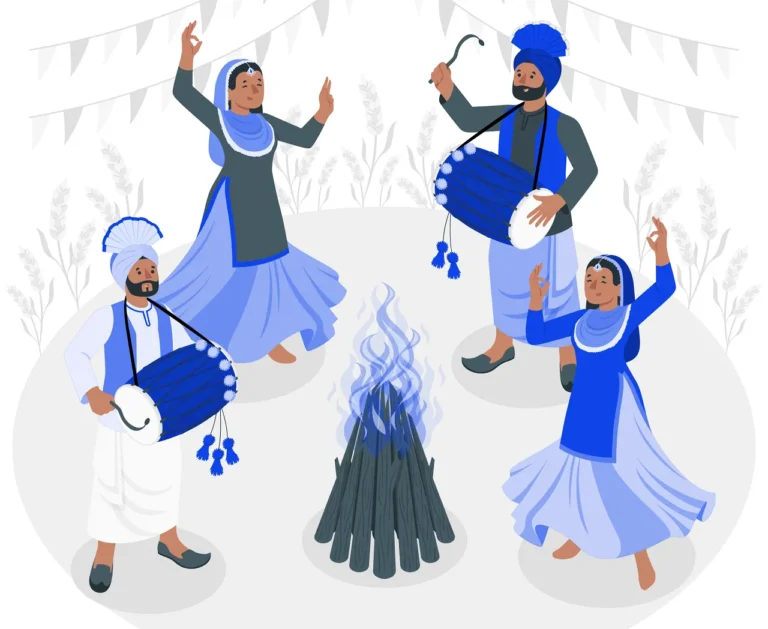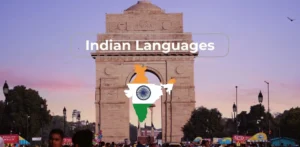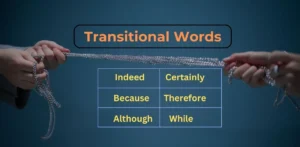The most popular and traditional Folk Dances of Jammu and Kashmir are Rouff, Hafiza, Bachha Nagma, Dumhal, Kud Dance, Geetru, Bhand Pather, Wuegi-Nachun, Bhumro Dance.
Here is a list of traditional dances in Jammu and Kashmir:
- Rouff
- Hafiza Dance
- Bachha Nagma
- Dumhal Dance
- Kud Dance
- Geetru
- Bhand Pather
- Wuegi-Nachun
- Bhakh
- Rauf Dance
- Dogri Dance
- Bhumro Dance
Each of these dances reflects the deep-rooted culture, traditions, and joyous celebrations of the people.
Popular Folk Dances of J&K
Kashmir Dances
In Kashmir, the popular dances of Rouff, Hafiza, Bacha Nagma, and Dumhal surprise spectators with their grace, rhythm, and expressive movements.
Rouff:
Rouf Dance, a renowned traditional dance form of the Kashmir region, holds a special place in festive celebrations like Eid and Ramzan.
This famous dance is performed by a group of women, standing face to face, showcasing their synchronized movements and rhythmic footwork.
The incredible footwork, synchronized steps, and expressive hand gestures showcase the skill and artistry of the performers.
Adorned in vibrant phirans (long woolen robes) and traditional jewelry, the dancers create a captivating visual spectacle.
Rouf Dance, also pronounced as ‘ruf’ in villages and ‘row’ in cities, is deeply ingrained in the cultural fabric of Jammu and Kashmir.
Rouf Dance is also known as Wanvun.
Bacha Nagma:
Bachha Nagma is a captivating dance form performed exclusively by boys at cultural gatherings and special functions.
With a group size of six to seven members, this dance features a lead singer accompanied by chorus vocals, creating a soothing and harmonious atmosphere.
It involves fast footwork, lively music, and expressive gestures.
Bachha Nagma showcases the energetic and melodious talents of young voices, leaving a lasting impression on the audience.
Hafiza:
Hafiza Dance, a captivating Kashmiri traditional dance, takes center stage at weddings.
This enchanting dance is accompanied by a special instrument called Santoor, which features nearly a hundred strings and is played using sticks.
The melodic tunes of the Santoor add a mesmerizing element to the performance, enhancing the overall experience.
Dumhal:
Dumhal Dance, the famous dance form of Kashmir, showcases its uniqueness and exclusivity.
Reserved for special occasions, only men from the Wattal community perform this dance.
Dressed in vibrant robes and adorned with beautiful conical caps, the dancers create a mesmerizing spectacle.
With a banner planted in the ground, they dance in a ritualistic manner, accompanied by melodious singing and rhythmic drum beats.
Dumhal Dance epitomizes the rich cultural heritage of Kashmir, embodying grace, tradition, and a sense of exclusivity.
Bhand Pather:
Bhand Pather, a unique form of theatrical dance in Kashmir, goes beyond just dance.
It incorporates captivating plays that engage and enthrall the audience.
This art form portrays the nuances of everyday life, traditions, and societal issues prevailing in the region.
Bhand Pather is a brilliant fusion of dance, drama, and social commentary, offering a rich cultural experience that leaves a lasting impact.
Wuegi-Nachun
Wuegi-Nachun is a celebratory dance form performed by Kashmiri Pandit females as a farewell to the bride as she leaves her parental home after the wedding rituals.
In this joyful dance, the women gather around the bridal rangoli, a traditional art form created on the floor, and engage in lively and spirited movements.
Wuegi-Nachun is a heartwarming expression of love, blessings, and well-wishes for the bride as she embarks on a new chapter of her life.
Also Read: History Of J&K
Jammu Region:
Meanwhile, in Jammu, the region resonates with the joyous beats of Rauf, Geetru, Kid, Dogri Dance, Hikat, and Ghoomar.
Kud Dance
Kud Dance is a renowned dance form of Jammu and Kashmir performed at night as a powerful expression of gratitude to the gods.
With captivating movements and pulsating beats, this inclusive dance form unites both young and old participants.
Amidst the majestic mountains of Jammu, farmers gather during the rainy season to thank the local deity for protecting their cattle, crops, and families.
Adorned in their finest attire, they celebrate through the night, creating a vibrant spectacle.
Geetru:
Geetru, a traditional dance form of the Jammu region, showcases the artistic prowess of women.
With graceful movements, swaying steps, and expressive hand gestures, Geetru dancers captivate audiences during religious festivals and ceremonies.
Adorned in colorful traditional attire and traditional jewelry, the dancers add a touch of elegance to the proceedings.
The dance is accompanied by devotional songs and melodic instruments, such as the harmonium and dholak, reflecting the region’s cultural and religious traditions.
Dogri Dance:
Dogri Dance is a captivating traditional dance form that embodies the vibrant Dogra culture.
With its rhythmic footwork, graceful movements, and vibrant costumes, Dogri Dance showcases the rich heritage and artistic traditions of the Dogra community in Jammu.
Related: Crops of J&K
Summary
These popular dances have stood the test of time, preserving the customs, traditions, and heritage of the people.
They transcend mere performances, serving as vibrant expressions of the people’s deep-rooted connection to their land, their beliefs, and their celebrations.
FAQ’s
Q: What are the traditional dances of Jammu and Kashmir?
A: Some traditional dances of Jammu and Kashmir include Rouff, Hafiza, Bacha Nagma, Dumhal, Rauf, Kud, Geetru, and more.
Q: Which region of Jammu and Kashmir is known for Rouff dance?
A: Rouff is a traditional dance form popular in the Kashmir region of Jammu and Kashmir.
Q: What is the significance of Dumhal dance?
A: Dumhal is a folk dance associated with the Wazwan community in Kashmir.
It is performed during religious processions and festivals, reflecting the community’s devotion and unity.
Q: Which dance form represents the beauty of spring in Kashmir?
A: Hafiza dance represents the beauty of nature, specifically the blooming of flowers during the spring season, in Kashmir.
Q: What is the purpose of Rauf dance?
A: Rauf dance is performed during the harvest season in the Jammu region, celebrating a successful crop yield and expressing gratitude for nature’s abundance.
Q: Are traditional dances of Jammu and Kashmir performed by both men and women?
A: Yes, some traditional dances, such as Rauf and Bacha Nagma, are performed by both men and women together.
Q: Where are traditional dances of Jammu and Kashmir often performed?
A: Traditional dances are often performed during weddings, festivals, cultural events, religious processions, and social gatherings in Jammu and Kashmir.
Q: How do the dancers dress for traditional dances in Jammu and Kashmir?
A: Dancers wear colorful traditional costumes, including phirans, robes, headdresses, and traditional jewelry, depending on the specific dance form.
Q: What musical instruments accompany traditional dances in Jammu and Kashmir?
A: Traditional dances are accompanied by various musical instruments, such as santoor, rabab, tumbaknari, saz-e-Kashmir, harmonium, dholak, drumbeats, and flute melodies.
Q: What do the traditional dances of Jammu and Kashmir reflect?
A: The traditional dances reflect the cultural heritage, social customs, religious traditions, and natural beauty of the Jammu and Kashmir region.




